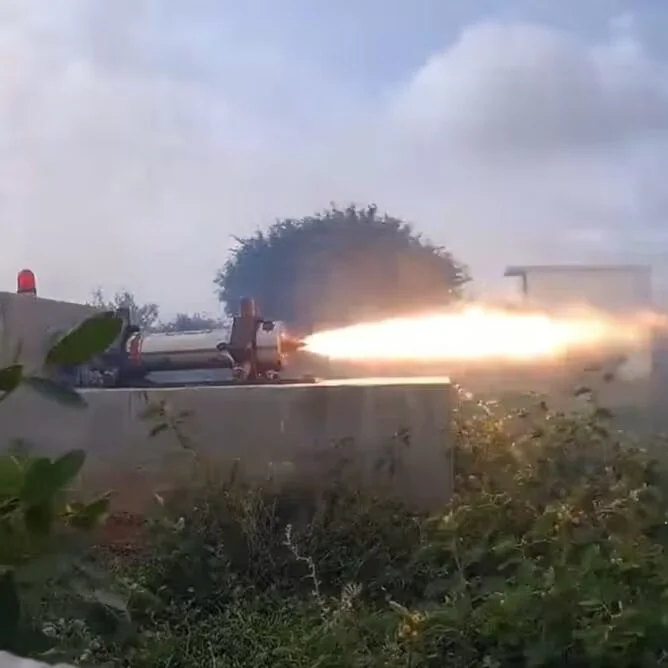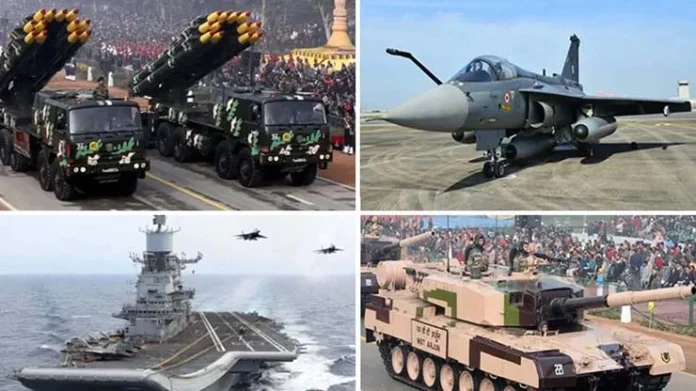AFI
SOURCE: AFI


In a recent feature, Russian media outlet Sputnik has extolled the capabilities of the Su-57, Russia’s advanced fifth-generation fighter jet, positioning it as a formidable force in modern aerial warfare. According to Sputnik, the Su-57, which celebrated its maiden flight 15 years ago, is not just a match but an outright superior to its international counterparts.
Sputnik describes the Su-57 as a dual-role aircraft, adept at both attack and fighter missions. Its design incorporates stealth technology, making it “nearly invisible” to enemy radar systems while boasting exceptional maneuverability. The jet is claimed to have a service ceiling of 20 kilometers, a range extending up to 5,500 kilometers, and a top speed reaching 2,470 kilometers per hour, which positions it as one of the fastest in its class.
Continue readingSOURCE: AFI


In this year’s Aero India show, set to be held in Bengaluru, the participation of the Indian Air Force’s acclaimed Sarang display team hangs in the balance. The uncertainty stems from the grounding of all 330 HAL Dhruv advanced light helicopters (ALH Dhruv) after a concerning crash in January.
Sarang, renowned for its intricate and visually stunning aerial maneuvers, has been a staple attraction at Aero India, contributing to the spectacle that draws aviation enthusiasts from around the globe. This biennial event has traditionally featured both Sarang and the Suryakiran aerobatic team, showcasing India’s aerial prowess alongside international teams.
Continue readingSOURCE: AFI


In a significant upgrade to their combat gear, Indian Army troops deployed at the strategically vital Uri sector in Jammu and Kashmir have been observed sporting new Armasen plate carriers alongside advanced Level III+ Advanced Combat Helmets (ACH). This development points to a continuing effort by the Indian military to bolster the protection and operational effectiveness of its soldiers in forward areas.
The troops were equipped with the Armasen plate carriers, known for their robust design and ergonomic features. These carriers are designed to accommodate various types of ballistic plates, offering flexibility in terms of protection levels. The Armasen gear, particularly the SF RIG (Special Forces Rapid Interchangeable Gear) and GRIP Combat Belt, is noted for its compatibility with both standard and custom ballistic plates, enhancing mobility and comfort in combat situations.
Continue readingSOURCE: AFI


In a significant step towards bolstering indigenous capabilities in drone technology, Indian startup IG Drones has announced the sale of its Vertical Take-Off and Landing (VTOL) and First-Person View (FPV) drones to the Indian Army. This development aligns with India’s push for self-reliance in defense manufacturing under the ‘Make in India’ initiative and comes amid rising concerns over the use of foreign components in critical defense systems.
The deal is particularly noteworthy in light of an incident last year, where an Indian Army drone, suspected to contain Chinese-manufactured components, was reportedly hijacked near the Line of Control (LoC). The incident raised alarms about the vulnerabilities posed by foreign-origin systems, including risks of cyber espionage and compromised operational security.
Continue readingSOURCE: AFI


In a significant leap forward for India’s propulsion technology, SpaceFields has announced the successful hot-firing of its pioneering AeroSpike solid rocket engine. This achievement marks a new chapter in the country’s aerospace capabilities, demonstrating both innovation and practical application in rocket propulsion.
The static-test campaign took place at SpaceFields’ Propulsion test facility located at the Indian Institute of Science (IISc) in Challakere, Chitradurga district. The AeroSpike engine, with its unique design, features a 168mm diameter and a length of 1.36 meters, employing an HTPB-based composite propellant known for its efficiency and stability.
Continue readingSOURCE: AFI


As India strives to achieve self-reliance in defense manufacturing under the Atmanirbhar Bharat initiative, it is time to establish a dedicated Research and Development (R&D) fund for the defense sector. This fund should not only cater to state-run defense organizations like DRDO but also extend support to the private sector, startups, and academia. A well-structured R&D fund can unlock the potential of India’s defense ecosystem, fostering innovation and accelerating the development of cutting-edge military technologies.
India’s defense sector has often lagged in technological innovation due to limited resources and reliance on imports. A dedicated R&D fund would encourage indigenous development of advanced systems like AI, hypersonics, cyber defense, and UAVs.
Continue readingSOURCE: AFI


In a startling incident at a Russian airport, security officials have seized a bottle containing radioactive Thorium-232, with radiation levels measured at fifteen times the permissible limit. The substance was found in the luggage of a tourist who claimed innocence, stating that the material was simply “volcanic beach sand” collected during her visit to India.
The incident unfolded at Moscow’s Domodedovo Airport, where routine security checks have become more stringent following global security concerns. As part of these measures, the bottle was detected during a scan that triggered a radiation alert. Upon further examination, it was confirmed that the contents were indeed Thorium-232, a naturally occurring radioactive element which, in this instance, posed a significant health risk due to its concentration.
Continue readingSOURCE: AFI


Adani Defence, a leading entity in India’s defense manufacturing sector, has announced that the Long Range Glide Bomb (LRGB), named GAURAV, has now entered the Low Rate Initial Production (LRIP) phase. This marks a significant milestone in enhancing India’s precision strike capabilities from the air.
GAURAV, an indigenously designed and developed 1,000 kg class glide bomb, is engineered to strike targets with high precision over long distances. Once launched from an aircraft, GAURAV uses a sophisticated hybrid navigation system, combining Inertial Navigation System (INS) and Global Positioning System (GPS) data, to steer accurately towards its target. This system allows for increased accuracy, even in GPS-denied environments, making GAURAV a formidable weapon in modern warfare scenarios.
Continue readingSOURCE: AFI


A recent analysis by the authoritative website globalfirepower.com has spotlighted the global pecking order in aerial military might, evaluating countries based on their total aircraft inventory which encompasses fighter jets, helicopters, and support aircraft. According to the report, the world’s most formidable air forces are led by the United States, with Russia and China securing the second and third positions, respectively.
India has been ranked fourth in this comprehensive assessment, showcasing its significant air power with an inventory of 2,296 aircraft, including helicopters, fighter jets, and support aircraft. This ranking underscores India’s ongoing efforts to modernize and expand its air force capabilities amidst regional security challenges.
Continue readingSOURCE: AFI


DroneAcharya Aerial Innovations Limited proudly announces the securing of a significant contract valued at INR 18,70,500 from the Indian Army. This contract marks a pivotal step in the company’s journey towards enhancing the technological capabilities of the nation’s defense forces.
Under the terms of this contract, DroneAcharya will establish a specialized Drone Training Lab dedicated to the training of army personnel. The initiative includes the provision of essential hardware and comprehensive drone flying lessons tailored for military applications. The project officially began on January 27, 2025, with a completion deadline set for March 28, 2025.
Continue readingSOURCE: AFI


Bharat Electronics Limited (BEL), India’s premier defense electronics company, has announced that it has secured additional orders worth Rs. 531 crore since its last disclosure on January 13. These new contracts span multiple domains, reaffirming BEL’s critical role in strengthening India’s defense and technology infrastructure.
With the latest additions, BEL’s total order book has further expanded, demonstrating the trust and confidence reposed in the company by various defense and civilian stakeholders. The company continues to reinforce its position as a key supplier of cutting-edge technology to the Indian Armed Forces and other strategic sectors.
Continue readingSOURCE: AFI


In a landmark event for India’s defence sector, the Anti Stealth VHF Radar, a product of collaboration between the Electronics and Radar Development Establishment (LRDE) and Bharat Electronics Limited (BEL), was officially launched today at BEL’s facility in Ghaziabad. This cutting-edge radar system, designed to counter stealth technology, represents a significant advancement in India’s Indigenous defence capabilities.
The newly unveiled radar system comes equipped with advanced surveillance features, including a ‘staring capability’ that allows for the detection of stealth targets at extended ranges. This technology is particularly noteworthy as it challenges the effectiveness of stealth aircraft and other low-observable platforms, providing the Indian military with a strategic edge in aerial surveillance and defense.
Continue readingSOURCE: AFI


In a decision that has defense enthusiasts buzzing with excitement, India has chosen ThyssenKrupp Marine Systems (TKMS) over Spain’s Navantia for its next-generation submarine procurement under Project 75-India (P75I). This choice marks a significant step forward in India’s naval capabilities, particularly in stealth technology and strategic maritime operations.
The submarine on offer from TKMS is described as a next-generation design, boasting a faceted hull that introduces Low Observable (LO) features. This design enhances the submarine’s stealth capabilities, making it the 5th generation of the diesel-electric attack submarine (SSK) with an emphasis on reducing its acoustic and radar signatures. The innovative hull shape is a radical departure from traditional designs, aiming to deflect sonar emissions, thereby making the submarine less detectable by modern anti-submarine warfare (ASW) systems.
Continue readingSOURCE: AFI


In a significant step forward for unmanned aerial vehicle technology, NewSpace Research and Technologies has unveiled a new type of long-endurance helicopter UAV. This innovative aircraft stands out with its streamlined design, featuring a tail rotor that enhances efficiency and stealth capabilities. The sleek, aerodynamic shape promises improved flight dynamics, making this UAV a potential game-changer in aerial surveillance and reconnaissance.
The helicopter UAV is not just about its unique design; it boasts a sophisticated tri-sensor gimbal camera system, which suggests capabilities for comprehensive day and night surveillance, thermal imaging, and high-resolution photography. This setup is ideal for various applications, including border security, disaster management, and military intelligence gathering, offering versatility in operational environments.
Continue readingSOURCE: AFI


In an exciting development for India’s aerospace sector, Prateek Dhawan, co-founder of DG Propulsion, has shared significant updates on the testing of their jet engines. The company, known for its pioneering work in propulsion technology, recently conducted a rigorous test where their engines operated in a vertical configuration for a full hour. This test not only included variable throttle adjustments to assess responsiveness but also maintained the engines at full throttle for the majority of the time.
Dhawan took to social media to share this milestone, although he noted with regret that the third video of this test session was not recorded. Despite this, the success of the test is a clear indicator of DG Propulsion’s advancements. “Jetsuits can absolutely be built in India now,” Dhawan confidently asserted, signaling a pivotal moment for the company and the Indian aerospace industry at large.
Continue reading